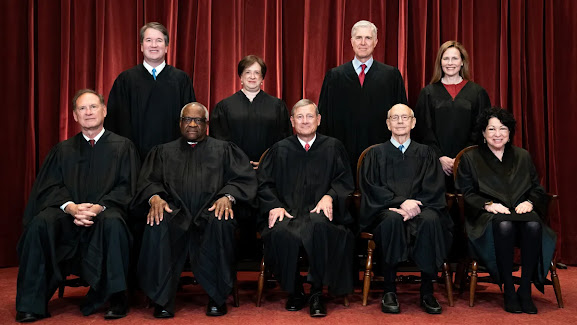Week 7: SCOTUS
United States Supreme Court Justices
Last week we reviewed Article 3 of the US Constitution; all about the Judicial Branch. We learned that:
- Congress has the power to create lower courts to lighten the case load of the Supreme Court,
- the Supreme Court has both original and appellate jurisdiction, depending on the type of case,
- judges are appointed by the US president for life (as long as they behave themselves), but their appointments must be approved by the Senate,
- thanks to the the decision in the most influential court case in US history, Marbury v. Madison, the Supreme Court has the power of Judicial Review, or the power to review all laws and statutes for compliance with the Constitution, and
- there are no real checks on the Supreme Court, as there are for the other two branches of government, except for impeachment.
Thomas Jefferson was very wary of the potential of the Supreme Court to gradually usurp power from the executive and legislative branches of government. In 1821 he wrote,
"...the germ of dissolution of our federal government is in the constitution of the federal judiciary; an irresponsible body (for impeachment is hardly a scare-crow) working like gravity by night and by day, gaining a little today and a little tomorrow, and advancing its noiseless step like a thief, over the field of jurisdiction, until all shall be usurped from the States, and the government of all be consolidated into one."
Like any part of government, there have been good and bad times with the Judicial Branch, just like "fire...a dangerous servant and...fearful master" as George Washington described it. When judges honestly and unbiasedly stick to the Constitution, it usually turns out pretty well for the American people. But when they begin to exercise judicial activism, letting their own biases influence their decisions, somebody always ends up being denied justice.
In case you missed anything in class (Liam) here are some videos to help you catch up:
ASSIGNMENTS:
WRITING: Select a Supreme Court case from the past and write an essay about it giving the following information:
- explain what the case was about (the problem),
- explain the decision/ruling of the Supreme Court,
- tell if and why the decision/ruling has been good or bad for our country.
This should be written as an essay, not a list. Please do not use bullet or numbered points. Remember to start with a thesis/main idea that gives a very brief answer to all three parts of the question in one statement, then use separate paragraphs to explain the different parts of the question.
In case you lost your selected court case, here are the assignments once again:
- Braeden - Wickard v. Filburn (1942)
- Kellen - Brown v. Board of Education (1954)
- Liam - Dred Scott v. Sandford (1857)
- Liya - Gideon v. Wainwright (1963)
- Miah - Engel v. Vitale (1962)
- Morgan - Plessy v. Ferguson (1896)
- Noah - Miranda v. Arizona (1966)
CONSTITUTION JOURNAL: Article 2, Section 2 - Article 3
DEVOTIONAL: Liya
CONSTITUTION BOWL:
MARK YOUR CALENDARS!!! May 20th 6:30-8:30 pm, location TBA.
More details will be provided in the coming weeks. Please let me know ASAP if the above date doesn't work for you so I can try to adjust things so everyone can participate!
CANDY TRIVIA:
Name all 9 Supreme Court justices in order of seniority (last names only are okay).
BONUS:
Who is the most recent Supreme Court judge nominee, and who is he/she meant to replace?




Comments
Post a Comment